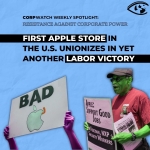US: Study Documents 'Ghetto Tax' Being Paid by the Urban Poor
Drivers from low-income neighborhoods of New York, Hartford and Baltimore, insuring identical cars and with the same driving records as those from middle-class neighborhoods, paid $400 more on average for a year's insurance.
The poor are also the main customers for appliances and furniture at "rent to own" stores, where payments are stretched out at very high interest rates; in Wisconsin, a $200 television can end up costing $700.
Those were just two examples among several cited in a report Tuesday showing that poor urban residents frequently pay hundreds if not thousands of dollars a year in extra costs for everyday necessities. The study said some of the disparities were due to real differences in the cost of doing business in poor areas, some to predatory financial practices and some to consumer ignorance.
The study, from the Brookings Institution, said finding ways to eliminate these added costs, often called a "ghetto tax," could be an important new front in the fight against poverty.
At a meeting connected with the report's release, officials from three states - New York, Pennsylvania and Washington - said they were already doing just that through a variety of programs to draw banks to poor neighborhoods, help finance the construction of supermarkets and encourage innovative insurance schemes.
"There's a large and for the most part overlooked opportunity here to help low-income families get ahead," Matt Fellowes, the Brookings researcher who wrote the report, said in an interview. "That is to reduce their costs."
Measures that reduced the price of essential goods and services for low-income Americans by just 1 percent would put an additional $6.5 billion a year in their hands, said the report, titled "From Poverty, Opportunity."
Sheldon H. Danziger, a poverty expert at the University of Michigan, noted that $6.5 billion was roughly one-third the benefit the same families have gained through the earned-income tax credit. "Certainly these measures could be an important source of income," Professor Danziger said of the report's findings. "But I don't see them as competing with things like raising the minimum wage, raising child subsidies and providing health insurance."
Citing other examples of the ghetto tax, the report found that nationally, 4.5 million low-income customers, defined as families making less than $30,000 a year, paid an average of two percentage points more for car loans than did middle-class buyers. And the common use of storefront check-cashing services by poor people, it said, comes at a steep price that varies with local regulations; in 12 cities studied, the fee for cashing a $500 check ranged from $5 to $50.
Part of the problem, the study found, is a discrepancy between the poor and the middle class in consumer skills and mobility: people who comparison-shop, especially on the Internet, tend to pay hundreds less for the identical car than those who walk onto a city lot and buy.
But the disparities can be reduced, the report said, not only by consumer education but also by some combination of incentives to lure banks and stores into poor neighborhoods and tighter regulation on things like the fees of storefront lenders.
The New York State Banking Department has drawn major banks into underserved neighborhoods by placing deposits of government money, sometimes at below-market interest, in the new branches. These may enable more residents to open accounts and reduce reliance on costly check-cashers and lenders, said the state's superintendent of banks, Diana L. Taylor.
In Pennsylvania, a program led by a Democratic state legislator, Dwight Evans, used state and private financing for construction of supermarkets in areas where residents had previously had to rely on costly small stores or drive long distances for groceries.
Washington State's insurance commissioner, Mike Kreidler, described efforts to restrict the use of personal credit scores by sellers of home and car insurance.
In a practice that has recently come into wide use in the industry, insurers study credit history to help judge the likelihood that a customer will file insurance claims; those with worse credit records are charged higher premiums, because, insurers say, the industry has found a correlation between poor ratings and the filing of claims.
But Mr. Kreidler and some consumer groups say that the insurers' approach is not transparent and consistent and that their method is likely to increase prices unfairly for poor people and minorities.
The insurance industry, on the other hand, argues that the new approach benefits many low-income consumers. "We think the use of credit scoring has allowed us to better serve urban areas," David F. Snyder, vice president of the American Insurance Association, said in an interview. Mr. Snyder said that with this more individualized tool, companies were less likely to raise rates for entire neighborhoods or categories.
- 188 Consumerism & Commercialism


